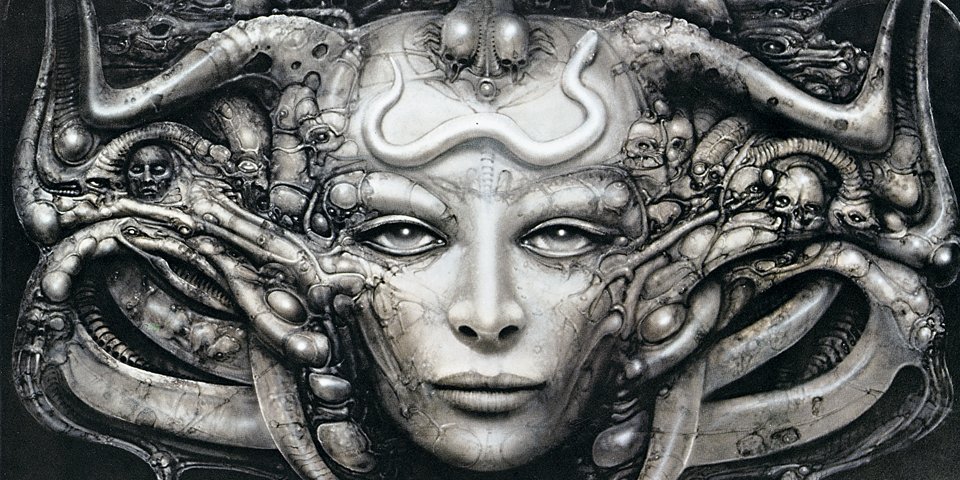A Dark Mind

Copyright HR Giger
I recently watched an intriguing documentary on Netflix called Dark Star: The World of H.R. Giger. If you don’t know who he is, Giger is an icon in the art world, pioneering a unique style of Gothic sci-fi art that is instantly recognizable. And even if you don’t know who he is, you certainly know his work. Giger created the most terrifying movie monster in film history, the soulless killing machine in Ridley Scott’s Alien. Giger’s style is a blend of organic and synthetic, drawing heavily from muscular and skeletal anatomy, fetuses, tentacles, and roots, along with pistons, wires, cables, rivets, and plating. But Giger did not simply create Borg-like nightmares; his work is definitely surreal and even whimsical, and more than a bit sexual. There is also a very dark edge to his creations, with numerous works featuring pentagrams and baphomet imagery. I suppose you could describe his style as “demonic sci-fi erotica.”
Aside from his Oscar-winning collaborations on Alien and the subsequent movies, he has a very devoted cult following in the Gothic and heavy metal communities, where his dark fantasies find fertile imaginations to take root. He is also the inspiration for a distinct tattooing style called “biomechanical,” which features organic designs of a futuristic nature. Claws and tendons merge with blades and wires, making the wearer look like a human/alien hybrid.

Copyright HR Giger
The documentary was a fascinating look at a famous artist at the very end of his life (he died only months after shooting wrapped in 2014) but there is a scene at the end of the film that struck me with a bit of sadness. As he looks into the mirror, he declares that he doesn’t believe in life after death, that there is nothing else after we die. While his work skew heavily towards the dark side of the psyche, there is little to suggest an active acceptance or invitation of Satanism. His works are almost always cold, monochromatic, and nihilistic, with hardly a shred of religious influence. One does not look at a Giger painting and say, “I can see hope.” It’s a shame that he died without knowing the God who gave him his incredible imagination.
I also got to wondering: if Giger’s work embodies dark or even demonic sci-fi art, what would Christian sci-fi art look like? Could such a thing even exist? I don’t know of any artists who paint futuristic cathedrals in the stars or robots praising God. Honestly, the notion is a bit silly. This doesn’t mean that Christianity and science fiction aren’t compatible (countless excellent books have already shown this compatibility) but as far as imagery goes, it would be hard for a science fiction artist to paint pictures that would make viewers think, “Yeah, I can really feel the worship in this piece” or “See how God’s love shines through the metal and glass?”
A quote that is often misattributed to Martin Luther says, “The Christian shoemaker does his Christian duty, not by putting little crosses on the shoes, but by making good shoes, because God is interested in good craftsmanship.” A Christian artist doesn’t have to paint divine pictures to be a Christian artist, and the challenge is exponentially harder if he or she is a sci-fi artist. Rather, the artist should strive to paint the best pictures they can, even if they are dark in nature. And if the artist is truly seeking to glorify God in their art, His grace will shine through, even if unintentionally.







































“I don’t know of any artists who paint futuristic cathedrals in the stars or robots praising God. Honestly, the notion is a bit silly. This doesn’t mean that Christianity and science fiction aren’t compatible (countless excellent books have already shown this compatibility) but as far as imagery goes, it would be hard for a science fiction artist to paint pictures that would make viewers think, ‘Yeah, I can really feel the worship in this piece'”
Good post, Mark, though I have to say that I don’t agree with the statement above. I think science fiction is fertile ground for a Christian artist. How many Hubble images have you seen? Every single one of them is a testimony to God’s glory. An artist couldn’t paint something similar?
Check out this image by Michael Whelan (used for an Asimov book). Can you look at that and not feel a little awe and wonder?
http://www.michaelwhelan.com/galleries/trantorian-dream/
I certainly feel the awe, but there is nothing specifically “Christian” about it. However, some of Giger’s work, such as this image, are indisputably demonic.
Atheists and Christians look at the same sky, yet the atheist is not compelled to tremble before God’s majesty. As you say, there is fertile ground, but I don’t know of anyone who has taken that artistic step of not just depicting the majesty of the stars but the majesty of the God who created those stars. Perhaps the stars themselves are enough 🙂
https://vikisecrets.com/uploaded/large/hr_giger_the_spell_iv.jpg
Yes, I wasn’t saying that Whelan’s work was Christian, only that there is a sense of awe and even a sense of the infinite in it. It is a hint of what could be done.
Someone should definitely do it. There is a ton of material in nature and fiction to mine.
I’ve been thinking about this: “artists who paint futuristic cathedrals in the stars or robots praising God.” And it would be cool to see.
But I was also thinking that part of the reason we may not have really seen it is our truth is so much more fantastic. When our reality is heaven and angelic choirs and spiritual warfare, the imagery is already pretty amazing.
(Also, it may be out there – just lesser known. Look at the work by Kevin Carden! http://www.christianphotoshops.com/Surreal/
I can’t speak for Akiane Kramarik’s faith but some of her pieces are pretty fantastical.)